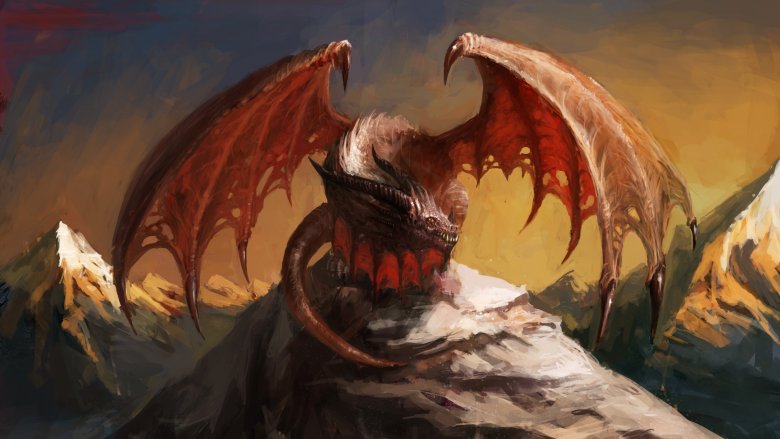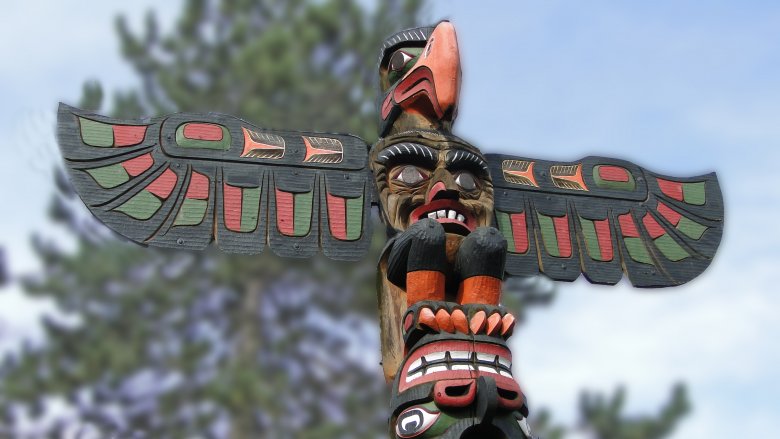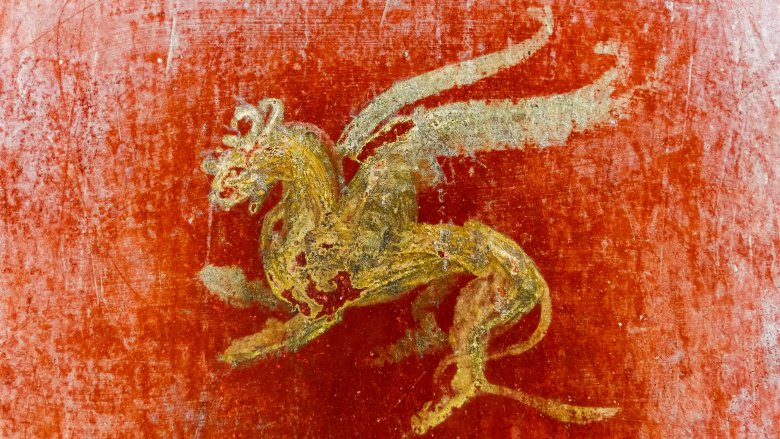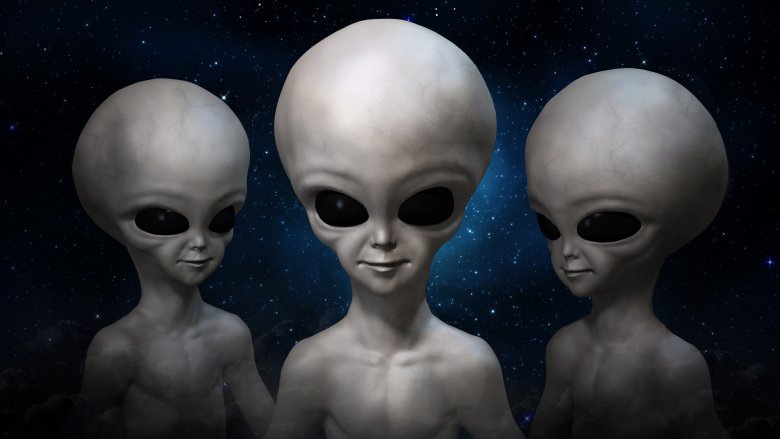Mythical Creatures That Might Have Actually Existed
Myths are by definition fantastical, often being stories told by ancient folks who wanted to explain a strange natural phenomenon or scare someone into good behavior. Because we're so much more rational and well-informed than our ancestors were, we modern humans know better than to believe in them. Most of us, anyway (we're looking at you, Bigfoot hunters).
But how would you feel if you knew that some mythical creatures may be based on reality? Maybe, just maybe, the kraken is still lurking somewhere out in the ocean. Maybe werewolves really did stalk medieval villagers. Maybe your eccentric neighbor really was abducted by aliens.
The terrifying truth is that some myths are not just totally made up or even based on a single kernel of truth; some are based on a whole bag of popcorn. While it's true that most of the mythical beasts you know from fairy tales and slow news days do not roam our modern world, some of them almost certainly did once, and a few of them might still.
The thunderbird
The thunderbird is a Native American legend about a bird so huge it can carry a small whale in its talons. Thunderbirds, which are said to be responsible for thunder and lightning, appear in several tribal traditions, from the plains to the northwest coast.
It's a pretty cool myth, sort of like the European notion of winged dragons, except more plausible. So plausible, in fact, that there are modern people who have reported seeing a bird with a wingspan of up to 20 feet in the Alaskan skies. Just to put that into perspective, that's roughly 2.5 times the wingspan of a bald eagle and at least 8 feet longer than the wingspan of a wandering albatross, which is currently believed to have the largest wingspan of any living bird.
Because scientists always like to spoil everyone's fun, some biologists have suggested that the sightings could be a Steller's sea eagle, which is larger and heavier than a bald eagle, and similar sightings could have prompted the thunderbird legends centuries ago. What's unusual about this claim is the Steller's sea eagle mostly spends time in Russia and Japan, though it's possible a few could have gotten lost or strayed further to find food.
The kraken
The kraken has terrorized sailors and Captain Jack Sparrow for centuries — this horrible creature was said to have long tentacles able to "suction your face clean off" and pull an entire ship beneath the waves. Scientists today are pretty sure that the legends are based on very real giant squid, though it's unlikely giant squid are particularly fond of sinking ships or suctioning off the faces of quirky pirates.
Like pretty much all legendary beasts, especially the sorts of legendary beasts that enjoy killing people, the kraken was said to be disproportionately huge, roughly the size of "a number of small islands." This is similar to the phenomena that makes people think they saw a 20-foot wingspan on a Steller's sea eagle or a wolf spider the size of a salad plate. Call it the "eek factor," if you will. Real giant squid aren't quite that big, but according to the BBC they can grow up to 50 feet in length, which let's face it is big enough.
Kraken-like squid may have lived in a time before Jack Sparrow. At least one paleontologist believes he's found evidence of Triassic squid that were up to 100 feet in length, though his theory is not yet well-supported. And while it is true that Jack Sparrow was capable of sailing to some pretty weird places, it's not clear if he ever made it all the way to the Triassic. Maybe in Pirates 9.
Hobbits
Everyone knows a hobbit saved Middle-earth from a small piece of jewelry, but what's less common knowledge is the fact that a small-statured race of proto-humans really did share the Earth with larger human species between 190,000 and 50,000 years ago.
In 2003, LiveScience says archaeologists found the remains of a 3-foot-tall adult female in a cave on an Indonesian island. At first there was speculation that the skeleton was a person with microencephalia, a medical condition that causes short stature. A comparison of the skull with modern microcephalics, though, seemed to suggest it came from a typical individual. There were also other indications that these were the bones of an unknown species, such as extremely primitive feet (though scientists fail to say if they were particularly hairy feet). There also appears to be a disappointing lack of evidence of "elvish" ears and hobbit holes with round front doors, so scientists may already be losing the whole "hobbits are real" track.
Since that time scientists have found more examples of hobbits, known by the rather less-endearing scientific name "Homo floresiensis." No one really knows for sure why hobbits became extinct, though it seems obvious that it was thunderbirds, who could have just flown Frodo all the way to Mordor instead of making him go on that stupid, pointless journey and thus can probably be blamed for the downfall of the species at least in some roundabout way.
Dire wolves
Dire wolves are more than just giant, CGI canids whose sole purpose appears to be making Stark enemies wet themselves in fear. Dire wolves are based on real, albeit extinct animals that once lived not in Westeros but in North America.
Dire wolves lived during the Pleistocene, between 250,000 to roughly 10,000 years ago. Unfortunately, real dire wolves were not really the size of ponies, although no one denies the potential awesomeness of pony-sized wolves. They were larger than modern wolves, though, and could weigh as much as 200 pounds — almost twice what a very large modern wolf might weigh.
Dire wolves are among the most common animals found in the La Brea Tar Pits (they probably tried to feed on other unfortunate victims and became trapped themselves). More than 200,000 dire wolf specimens have been uncovered at La Brea, representing more than 4,000 individuals. That's enough to take out most of the Army of the Dead and at least one smug Lannister queen. Who needs fire-breathing dragons?
The bunyip
The bunyip is not, in fact, a painful growth on a dire wolf's foot but a mythical creature said to haunt Australian swamps and rivers. The bunyip is an Aboriginal legend — according to Australian History, the name means "devil" or "spirit" and the creature is said to look like a cross between a crocodile and a horse, though accounts differ. Bunyips stalk and kill human beings and supposedly make an eerie sound like a "hollow boom," which certainly seems terrifying if you've never been around any shotguns or farm equipment.
The bunyip is a little like Australia's Loch Ness monster in that it lives in the water and has never been photographed despite the fact that hundreds of people have seen it. But the legend might have actually had rational origins. In 1839 the remains of an animal called a diprotodon was discovered in Australia, which proved that a huge, rhino-sized marsupial similar in appearance to a wombat once roamed the outback. Diprotodon was a plant-eater, but it's not hard to imagine that an angry one would be just as terrifying as an angry rhino or hippo.
It's unlikely that there are any surviving populations of diprotodons in Australia, but they only died out 20,000 to 40,000 years ago, which was long after the arrival of the aboriginal people. That suggests the legends might have come from real-life encounters between humans and diprotodons.
Dragons
While it's certainly true that dragons were never ridden by platinum blonde queens and probably never incinerated entire armies, if you put a medieval knight in the same room as a Dracorex hogwartsia and then asked the knight if dragons are real, he'd probably say yes. (And he'd be right, in this case. "Dracorex hogwartsia" is Greek for "dragon king of Hogwarts," and it's an actual dinosaur that got its name from a bunch of schoolkids.)
One probable hypothesis for the origin of the dragon legend is the discovery of dinosaur bones — in one of his writings, fourth-century B.C. Chinese historian Chang Qu discussed the dragon remains that were found in the region that is now known as Sichuan province. It's likely that similar artifacts were also known in Europe, potentially giving rise to legends of fire-breathing monsters.
But if fossils weren't enough to inspire the imagination, it's also possible (and maybe even likely) that medieval people might have encountered actual dragons in Indonesia, home of the fearsome komodo dragon. According to the Smithsonian, wild komodo dragons can weigh more than 150 pounds and may exceed 10 feet in length, and contrary to what most people believe, medieval dragons weren't necessarily enormous. Raphael's famous painting of St. George and the Dragon depicted a beast no larger than a lion, not too far off from a real-life komodo dragon.
Griffins
The dragon might have a similar origin story to the griffin, a chimeric animal said to have the front half of an eagle and the back half of a lion; it's cool, but the lion kind of got the shoddy end of that deal. According to Ancient Origins, griffins appeared in ancient Greece, Persia, Egypt, and medieval Europe. In one 2,000-year-old story, griffins built nests near gold mines in the Gobi desert and would fiercely defend them from ambitious miners.
Probably not coincidentally, the bones of a certain dinosaur were once quite common in the same desert — so common that they would just start eroding out of hillsides without the help of paleontologists.
For modern paleontologists, the Gobi is another kind of gold mine. Dinosaur bones are so common there that one could say those ancient miners probably couldn't swing a pickax without hitting a protoceratops, a quadrupedal dinosaur with a hooked beak that looks so similar to the mythical griffin that it could easily be mistaken for one. From there it seems likely that the miners concocted fantastic stories of fearsome beasts that were half eagle, half lion, and stole their gold. And why not? That's about a million times more interesting than, "Dug for some gold today. Didn't find any."
The chupacabra
Dire wolves are cool, dragons are awesome, but some mythical creatures are downright terrifying. According to LiveScience, the chupacabra is a New World myth that originated in Puerto Rico, but it's not as old as you probably thought it was. The chupacabra is a vampiric creature first sighted near the turn of this century, which means it's not only a millennial, it's probably also Edward Cullen.
"Chupacabra" means "goat sucker," but it's also been known to drain the blood of dogs, cats, chickens, rabbits, and other domesticated animals. It can cover vast distances in a single leap, it has red eyes, and it also has big hair, which is further evidence in favor of the Edward Cullen theory.
Chupacabras don't glitter, though. The most recent sightings describe them as having an almost canine appearance, with thick, hairless skin like an elephant. And unlike other crypto creatures, chupacabras do not appear to be capable of hiding their dead. People have actually killed or found the corpses of animals believed to be chupacabras, which means the beast is an easily solved mystery. Chupacabra corpses almost exclusively turn out to be coyotes suffering from a severe form of mange, which causes them to lose their hair. If you've ever been terrified by the sight of a hairless chihuahua (and who hasn't), you can probably pretty easily imagine how a person might mistake a hairless coyote for a blood-sucking monster. Or Edward Cullen.
The basilisk
Like the griffin, the basilisk is a cross between two terrifying creatures, although in this case it's really just one terrifying creature and a chicken. According to Mythology.net, basilisks are born when seriously confused roosters decide to sit on serpent's eggs, which is problematic because roosters don't typically sit on eggs of any kind, but never mind. Evidently the occasional mythical rooster feels like it must sit on eggs.
The mythical creature that emerges after a successful incubation has a rooster's head, a snake-like body, wings, and the legs of a chicken. It would potentially kill by making people laugh so hard at how ridiculous it looks that they don't notice they're about to be bitten.
Not all basilisks look stupid, though. Some are just very large, extra-terrifying snakes.
In either form, the basilisk spits fire and paralyzes with its gaze. It can move with the front part of its body upright, it lives in dry or sandy places, and only weasels can kill it. That's pretty clear evidence that the basilisk is based on the Egyptian cobra, which can also hold the front part of its body upright, spit venom, and stare lovingly into its victims' eyes just before striking. What's more, the cobra's only real enemy is the mongoose, which looks a lot like a weasel.
Werewolves
Werewolves have occupied our imaginations for centuries, but there's a really logical explanation for the legend. In the ancient world there was no such thing as vaccination, and rabies was common not only in wild animals but also in the family dog. According to Discover Magazine , a bite from a rabid animal could transform a person from an upright, rational, non-slathering hominid to an irrational, crawling, foaming-at-the-mouth animal that might attack and bite his or her friends and loved ones. Once a person was bitten, there was no way to stop the virus from taking over. And if that person happened to be particularly hairy, well, you can see how the werewolf legend might have been born.
Sadly, that means our modern understanding of werewolves is not in fact based on the actual existence of impossibly sexy, darkly moody, bare-chested shape-shifters that live in the Pacific Northwest, but normal human beings stricken with a horrific, 100 percent fatal illness. Sometimes the truth sucks.
Aliens
Most stories of alien visitation here on Earth can be explained by military testing, weather balloons, people who are hoping to write best-selling memoirs about their experiences with gray aliens, and Fox Mulder. There's no doubt that humans are obsessed by the idea of life on other worlds, and with good reason — because there is almost certainly life on other worlds. It's just not likely to have ever made it as far as Earth.
According to Space.com, NASA scientists are certain we will eventually find life on other worlds, and some scientists believe it will happen in the next two or three decades. But aliens are probably not going to show up here in beautiful, windowless spaceships, and they almost certainly aren't going to send Keanu Reeves down to the surface to discuss terms for saving Earth and the human species. They're likely just as stuck on their planet as we are on ours, which means detection will most likely come in the most scientifically boring way possible. We may find evidence of extinct microbes on Mars, for example, or scientists might discover something interesting while looking for "gases that may have been produced by life" in the atmospheres of Earth-like planets. Okay, so it kind of sounds like they'll be looking for planet-sized farts. Good luck, folks.
Giants
Almost every human culture has a version of a giant mythical creature. In the British Isles, there's even a legendary giant that has a name. Fionn mac Cumhaill was an Irish giant, said to have built and subsequently destroyed the famous "Giant's Causeway" (above) in Northern Ireland.
But giants aren't just legends. The modern world has plenty of examples of real giants, many of whom exceeded 8 feet in height. According to NC DNA Day, some of these modern giants live in Ireland, where a genetic pituitary tumor that causes unchecked growth (also known as gigantism) can be traced from a modern family all the way back to a 7'7" 18th-century circus performer whose bones are still on display at the Hunterian Museum. This genetic link suggests the mutation has been around for a long time, and may even go all the way back to Fionn mac Cumhaill himself, thus proving that giants are not just the stuff of some bored medieval storyteller's imagination. Sadly, golden geese and magic beans do not appear to have been based on real living things, though one never knows what archaeologists might someday discover in a forgotten ruin.




